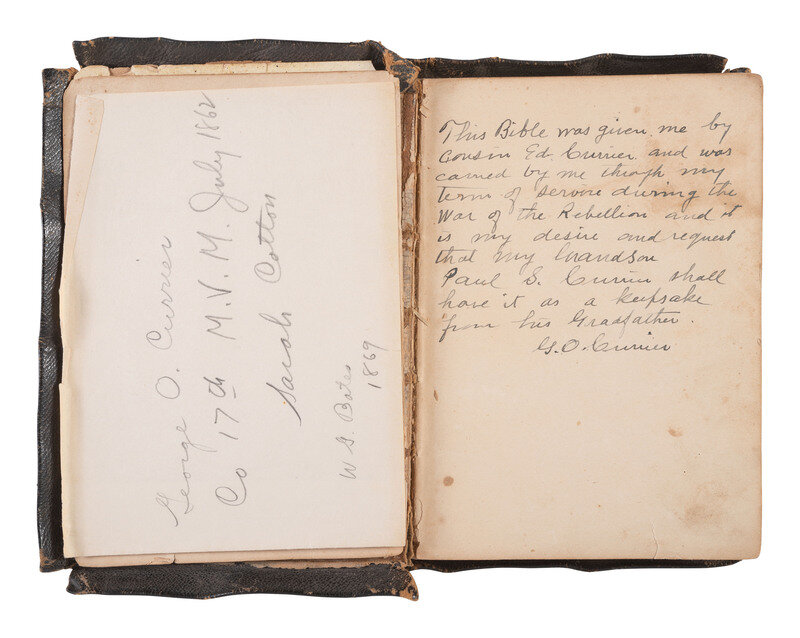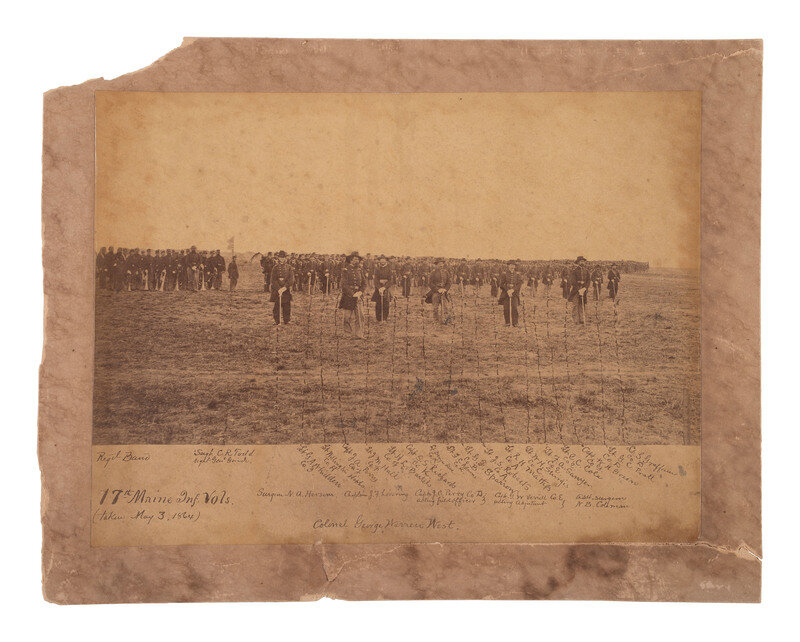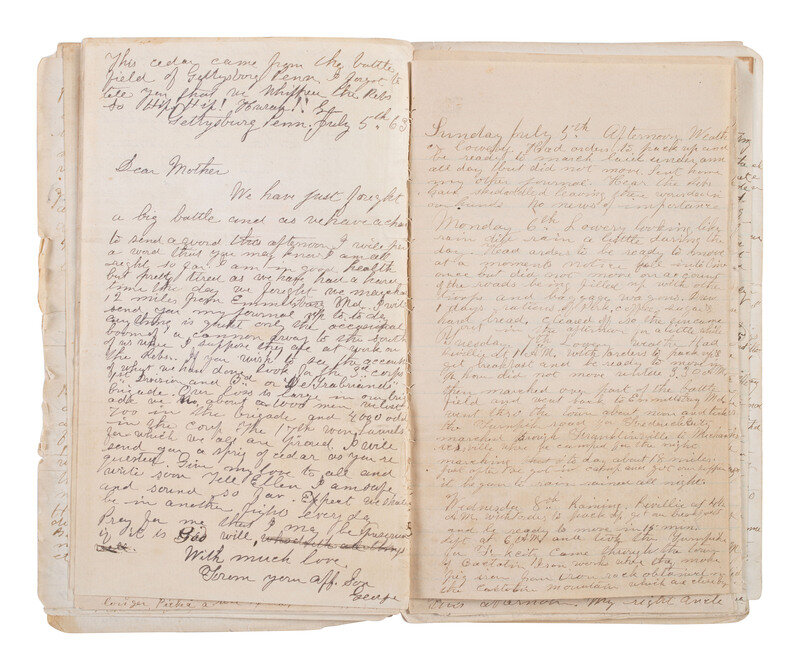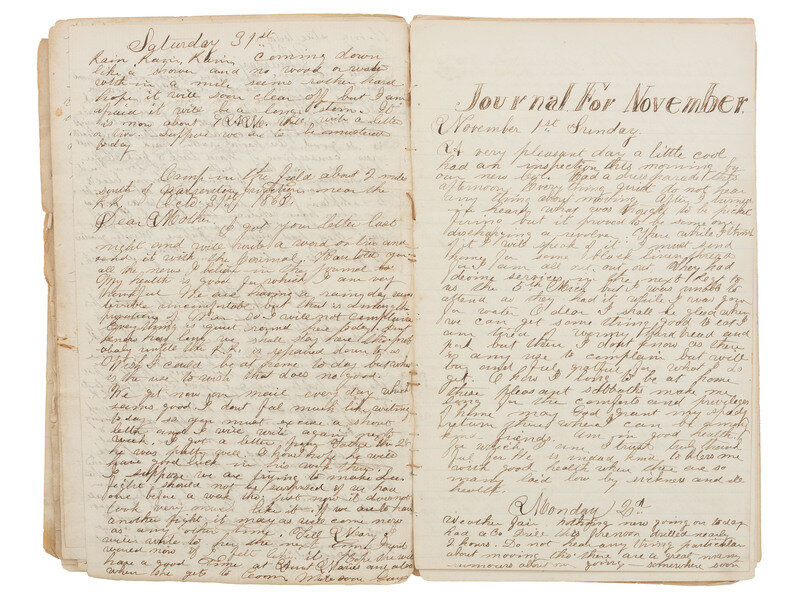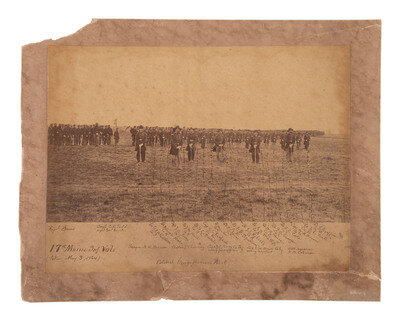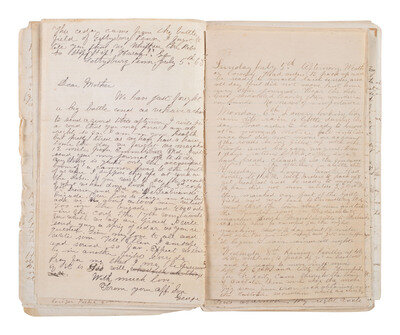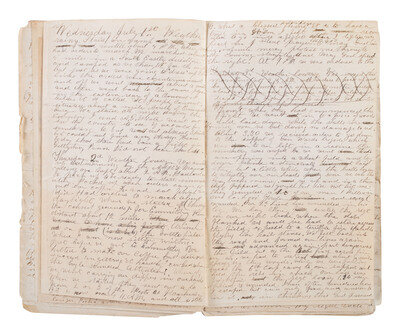Condition Report
Contact Information
Auction Specialist
Lot 60
Sale 6425 - American Historical Ephemera and Early Photography, including The Larry Ness Collection of Native American Photography
Part I - Lots 1-222
Oct 23, 2025
10:00AM ET
Part II - Lots 223-376
Oct 24, 2025
10:00AM ET
Live / Cincinnati
Own a similar item?
Estimate
$6,000 -
8,000
Price Realized
$6,000
Sold prices are inclusive of Buyer’s Premium
Lot Description
[CIVIL WAR]. Archive of George O. Currier, 17th Maine Infantry, incl. journal with significant GETTYSBURG content, among other important battles. 1863-64.
THIS CEDAR CAME FROM THE BATTLEFIELD OF GETTYSBURG, PENN. I FORGOT TO TELL YOU THAT WE WHIPPED THE REBS SO HIP! HIP! HURRAH!
Archive includes:
A makeshift journal created from pages that Currier sent home to his parents, along with letters addressed to them, later bound together with string. Comprises 140 pages of writing with daily entries spanning from 14 April 1863 - 2 March 1864 (very minor gaps), approx. 5 1/2 x 8 1/4 in.
Leather bound Bible carried by Currier throughout his service in the war, approx. 4 x 5 3/8 in. (some endpapers disbound, some loosening to binding in other areas, leather edges loose from pastedowns, pages with brown spotting and light wear). New York: American Bible Society, 1860. Currier has inscribed the following message on a flyleaf: "This Bible was given me by cousin Ed Currier and was carried by me through my term of service during the War of the Rebellion and it is my desire and request that my Grandson Paul S. Currier shall have it as a keepsake from his Grandfather. G. O. Currier."
8 3/4 x 6 1/2 in. albumen photograph of the 17th Maine Infantry Regiment, on larger cardstock mount (significant toning throughout, heavy wear and losses to mount). 3 May 1864. Image features commissioned officers standing out in front, closest to the camera, the regimental band standing to the viewer's left, and the rest of the regiment gathered in rows behind the officers. Tents are also visible in the distance. Inscribed in the margin of the photograph are the identities of the officers, with dotted lines connecting each name to the pictured officer. -- CDV portrait of a soldier in uniform with his arms and legs crossed, presumably George Currier (two significant holes to upper edge, additional wear and losses to edges). Verso inscribed, "Apr. 7th 1864 / Near Brandy Station Va." Uncredited. -- 4 7/8 x 3 3/4 in. silver gelatin snapshot of four men at the 50-year Gettysburg anniversary battlefield reunion, two wearing hats with GAR wreaths, with tents visible in the background (toning, wear). Uncredited. Verso inscribed: "Gettysburg battlefield reunion camp / July 1, 1913. / Leicester men in camp street. / Left to right, Messers.: / E. D. Bigelow / J. Q. Jordan / H. A. White / G. O. Currier." -- Together, 3 photographs.
[With:] Typewritten "Historical and Biographical Sketch of the Currier Family," 8pp. -- 2 full modern typed transcriptions of Currier's journal. -- And numerous handwritten loose leaf pages including some genealogical information about George Currier and the 17th Maine Infantry Regiment, but the vast majority of pages outlining the contents of various Civil War reference books.
Currier's experience as described in his journal offered here provides a genuine and compelling first-hand account of the realities of war for a man who is compelled to fight by responsibility to his country, but eager to return to his life on the farm. As he wistfully notes in an entry on 13 July, "Makes me think of home to see the farmers harvesting. It is great wheat country. Have seen thousands of acres all ripe and ready for the harvest. How thankful we ought to be that while our country is feeling the curse of war the Father above is still blessing us with bountiful harvest." He experiences a myriad of war events, and even a few non-war events, on his journey as part of the 17th Maine, including crossing the "Washington Farm" and seeing what they identified as the cherry tree that George Washington himself hacked at as a boy. Currier wisely notes, "Don't know whether it is the same tree or not, but they guard it..."
Currier's first major battle described in his journals takes place at Chancellorsville, where, in an entry dated 3 May, he writes, "About sunrise we were routed up and marched down where our Batteries were, then our folks sent skirmishers into the woods, which the Rebs drove back and advanced on us. We had to retreat back to another opening where we had other batteries placed. They commenced firing and during the day we fought one of the bloodiest battles that have been fought during this war." He totals the regiment's loss as 170 killed, wounded, and missing. He writes also that that while he emerged unscathed, he experienced several "narrow escapes."
In the lead-up to Gettysburg, Currier and his fellows participate in many drills in the heat of May. In an entry dated the 27th, he notes that 40 Kearney Crosses were presented to his regiment "for bravery and meritorious conduct," (at Chancellorsville). Though we do not know what all the celebration entailed, Currier tells us that they "Had a big time...We had a very good time indeed."
Orders to march appear to intensify over the next several weeks as the regiment makes their way toward Gettysburg. On 21 June, Currier writes that he hears heavy firing and booming coming from the direction of Leesburg, VA. He says there are rumors that there was a cavalry fight there. What he heard was the Battle of Upperville, indeed a clash of cavalries in Loudon County.
In his entry dated 2 July, Currier writes from the Gettysburg battlefield: "Arrived on the battlefield where I am now sitting writing...At 1 PM we were ordered to the front where they had commenced the fight. We went in to a piece of woods and laid down while the shells were flying over us but doing no damage to us. About 3:30 we received orders to go down to the support of Gen Wards Brigade which was to our left in a ravine. The musketry was awful. We went through an opening into a wheat field and lay down behind a stone wall...when the balls begun to whistle over our heads. Soon we saw the Grey backs coming. We up and into them they peppered us good but did not hit me. They wounded a lot of our men...We lay there untill [sic] the regt on our right broke. When the Rebs flanked us we had to retire across the field exposing us to a terrific fire, the balls flying like hail stones. We fell back into the road and formed our lines again. We advanced again part way across the field but as the Rebs had across [sic] fire on us. We had to retreat about a mile through the woods. While we were falling back the 6th Corp came to our support...Our loss was frightful, the Regiment losing 116 men killed or wounded...I fired 52 rounds during the fight, sat down on my knees and loaded and fired as fast as I could. I rather enjoyed it. I did not feel any fear at all."
As the battle continued the following day, Currier's participation shifted from active firing to forming a line of battle in support of the 2nd Corps and laying there, taking shell fire until dark. He reports the total loss from his regiment as 130 killed, wounded, and missing. Shortly thereafter, George authors a letter to his mother accompanying and referring to his journal pages. He writes, in part: "We have just fought a big Battle and as we have a chance to send a word thus, you may know I am all right so far...I will send you my journal up to today. Everything is quiet only the occasional boom of a cannon away to the South of us where I suppose they are at work on the Rebs. If you wish to see the account of what we have done look for the 3rd Corps, 1st Division and 3rd on Hildebrand's Brigade...The 17th Maine won laurels for which we are all proud. I will send you a sprig of cedar from the battlefield aws you requested...P.S. This cedar came from the battlefield of Gettysburg, Pennsylvania. I forgot to tell you that we whipped the Rebs so Hip! Hip! Hurrah!"
Other events of note in the aftermath of Gettysburg include a somewhat humorous false alarm for a cavalry raid, which Currier explains in his 9 July entry, was "occasioned by a mule getting loose and running into a man who thought the Rebs were on us for sure." Less than a week later, his regiment visited the Antietam Battlefield, where they saw the graves and remains of soldiers. On 15 July, he writes: "The rain has washed off the earth that covered them so now their bones are to be seen very plainly...Fearfully passed and old house of brick where the shells and solid shot had passed through nearly 20 times and it is all covered with bullet marks. Saw the famous McClellan's Lookout where he stood during the fight and watched the progress of the battle."
The sights and sounds of battle plague Currier and his fellows seemingly everywhere they go, be it crossing Kettle Run and seeing the Confederate graves of the 27th North Carolina at Bristoe Station, which Currier calls "too bad...the effects of war, cruel war" in an entry on 20 October; or hearing nearby heavy firing in the direction of Bull Run as Currier describes in an entry dated 27 October. His belief that a fight is coming soon is brought to fruition on 7 November at Kelly's Ford, where he says they drove the Confederate soldiers from their rifle pits and captured over 400 prisoners. He sums it up by saying, "We had a smart fight."
On 27 November, the regiment's next major engagement commences in Orange County, Virginia. Currier describes hearing skirmishing at a distance in front of him, and finding the Confederate troops at around 3 in the afternoon. He writes: "...The Rebels having massed their forces in our front, attacked us. Had a smart fight today. Our Regiment lost 52 men and our Company lost one man...I was hit by a spent ball on the wrist...The fight lasted until after dark when the Rebels fell back and held the field. I understand the name of this fight is Orange Grove or Locust Grove." In reality, the battle would become known as the Battle of Payne's Farm, Mine Run, or New Hope Church.
The regiment moved to winter quarters at Brandy Station, where they remained until late March of 1864.
George O. Currier (1844-1893) was a resident of Lewiston, Maine, when he enlisted as a private on 18 August 1862 at the age of 18. He mustered into Company D of the 17th Maine Infantry the same day. He was promoted once, to musician, sometime in 1864, and mustered out with his regiment in June of 1865 at Washington, DC.

